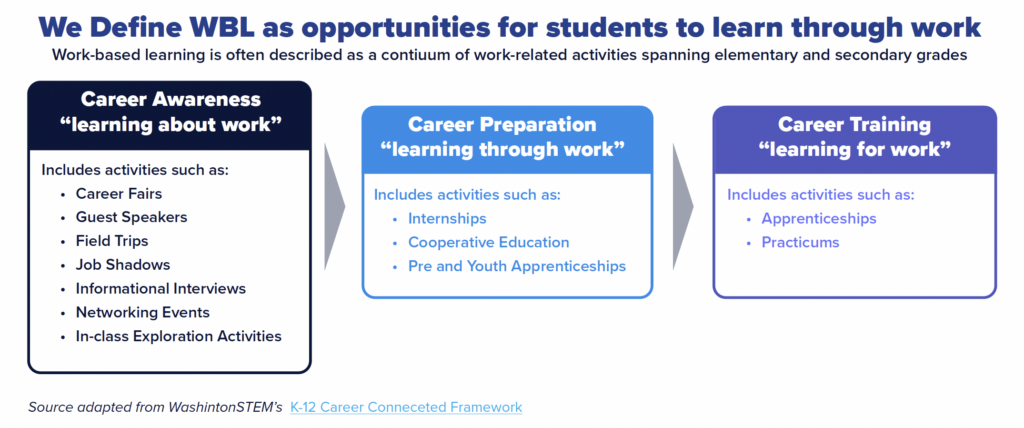Executive Summary:
Businesses today are struggling to fill open positions with skilled workers, often faulting our nation’s K-12 and higher education systems for not aligning learning curriculums with the skills needed for the modern workforce. Educators and school administrators point out that industry needs to do its part to bridge the gap between education and industry, by reaching back earlier into the workforce pipeline to help expose young people to the world of work, and ensure they are learning the skills needed before candidates interview for open jobs. The reality is education and employers must better work together to give middle- and high school-age youth the hands-on, workplace experiences they need to acquire durable professional skills for work and life, develop confidence, and build social capital.
But in order to ensure all students, including those from under-resourced schools and communities, and regardless of their socioeconomic background, gender, race, religion, disability status, sexual orientation or gender identity, have access to high-quality work-based learning, many more businesses will have to take steps to make career-connected learning opportunities available. And for that to happen, the return on investment for employers – the tangible benefits beyond the feel-good reason of giving back to the community — as well as proven solutions to overcome real barriers, must be better defined, documented and shared among business leaders, HR professionals and employees of all ranks.
Towards that end, American Student Assistance® (ASA) recently surveyed businesses on how (or if) they are putting in place work-based learning programs for youth younger than 18. We also explored the benefits they’re realizing as a result, and the challenges they face along the way. While work-based learning can ideally encompass a continuum of work-related exposure activities spanning elementary and secondary grades, our surveys typically asked about “high school internships” as that is the term most businesses use and recognize.

Key Takeaways:
The major highlights of our research include:
- High school internships are slightly on the rise. Building upon prior ASA research, our most recent survey found a small increase in the number of businesses offering these opportunities, from 30% in 2018 to 38% five years later. However, the number of available opportunities for this work remains low. That same 2018 survey found that only 2% of high students had actually completed a high school internship. While that number has likely risen since 2018, the 8 percentage point increase in employers providing programs likely only produced a small number of opportunities at each work site.
- Altruism plays a major role in business decisions to host high school interns. The majority of survey respondents (92%) cited giving back to the community as a somewhat or very important reason for providing an internship. Other important reasons included helping individual students gain skills (89%) and exposing students to careers that might be inaccessible to them (85%).
- Businesses with high school interns see benefits to their talent development and DEI strategies. While corporate social responsibility factors heavily into employers’ reasoning for instituting a high school internship program, businesses also anticipate real, tangible benefits to either their own organizations or their industry. Eighty-six percent of survey respondents said high school interns strengthened their industry pipeline as a whole; 81% said they filled their employment pipeline with diverse candidates and 78% said they enhanced their organizations’ Diversity, Equity and Inclusion initiatives; 77% said they used high school interns to build the pipeline for entry level positions; and 65% said interns reduced the workload of their full-time employees.
- High school internship programs can pose challenges, but businesses are finding solutions. Survey respondents cited the top three barriers in managing a high school internship program as: determining work best suited for them (43%); attracting qualified interns (42%); and scheduling around interns’ availability (39%). Employers also face challenges around interns’ lack of transportation to the workplace, having enough staff resources to manage interns, and securing funding for an internship program. But they are finding solutions, such as taking advantage of state funding to help subsidize intern pay.
- While one third of businesses say they are very or somewhat likely to start a high school internship program, more than a quarter (27%) say it is very unlikely. Small businesses are less likely than mid to large-sized businesses to show interest in beginning a program. An increase in funding for intern pay, the ability to identify a more suitable workload, and an opportunity to give back to the community are
the top three things that might motivate an organization to start a high school program.
Bringing youth work-based learning to scale nationwide is an important strategy in developing a U.S. education to-career continuum that both imbues individuals with the skills they need to attain family-sustaining jobs and lead healthy, productive lives, and provides industry with the skilled workforce needed to maintain global competitiveness amid rapidly changing economies and labor markets. With a better understanding of the benefits realized by providing access to the workplace for those younger than 18, as well as how to overcome common challenges, the business sector will be well-positioned to play an equal role alongside education in preparing today’s youth for tomorrow’s jobs.



